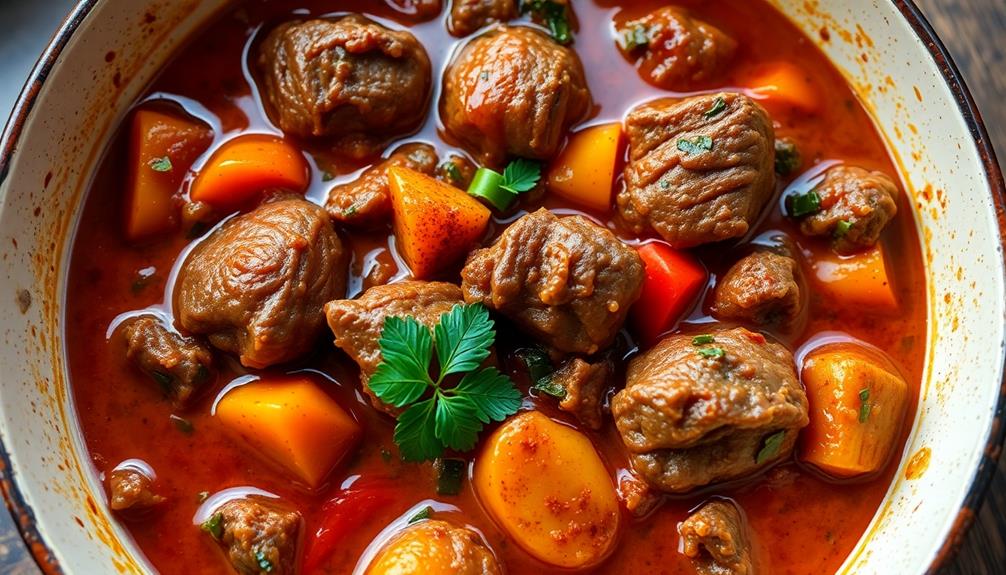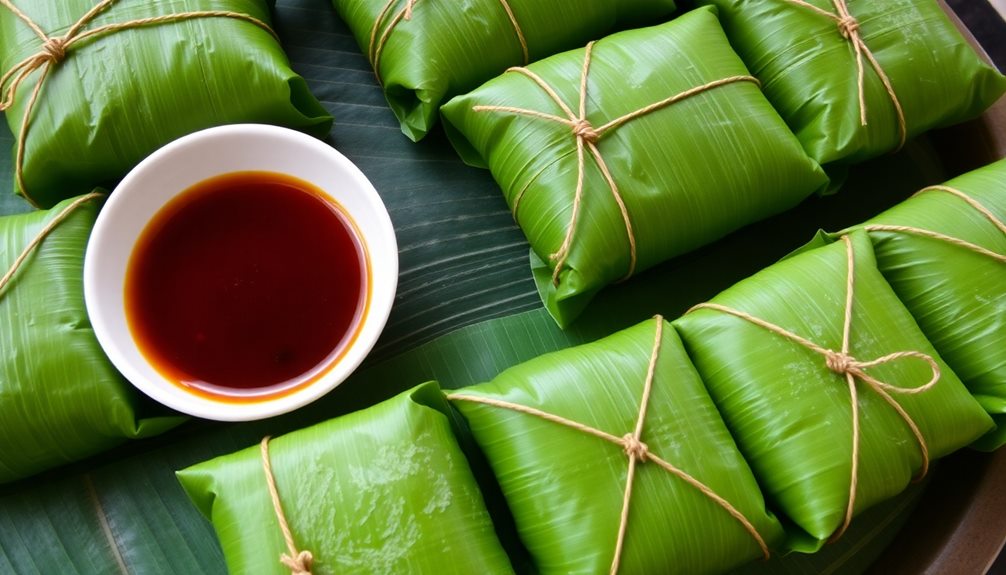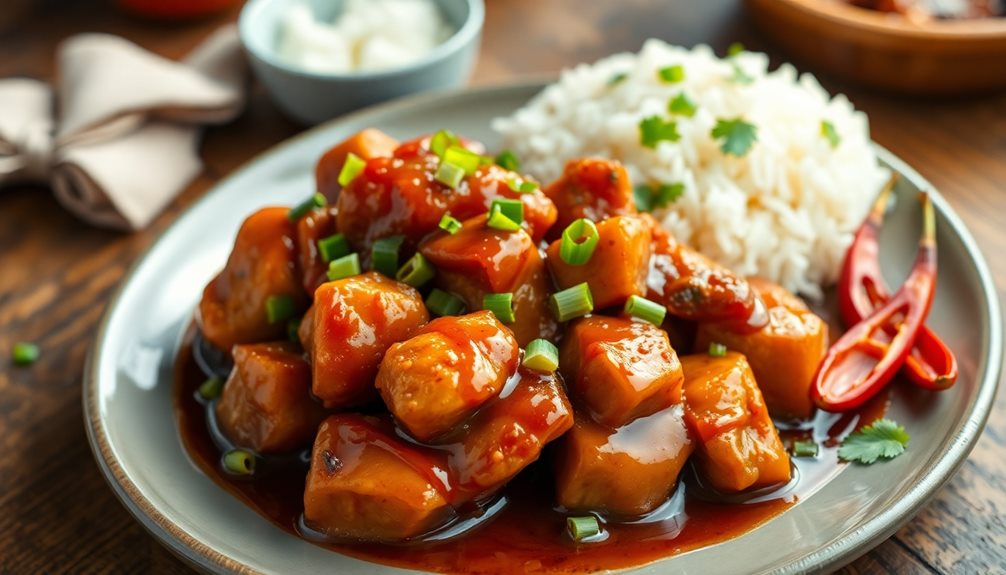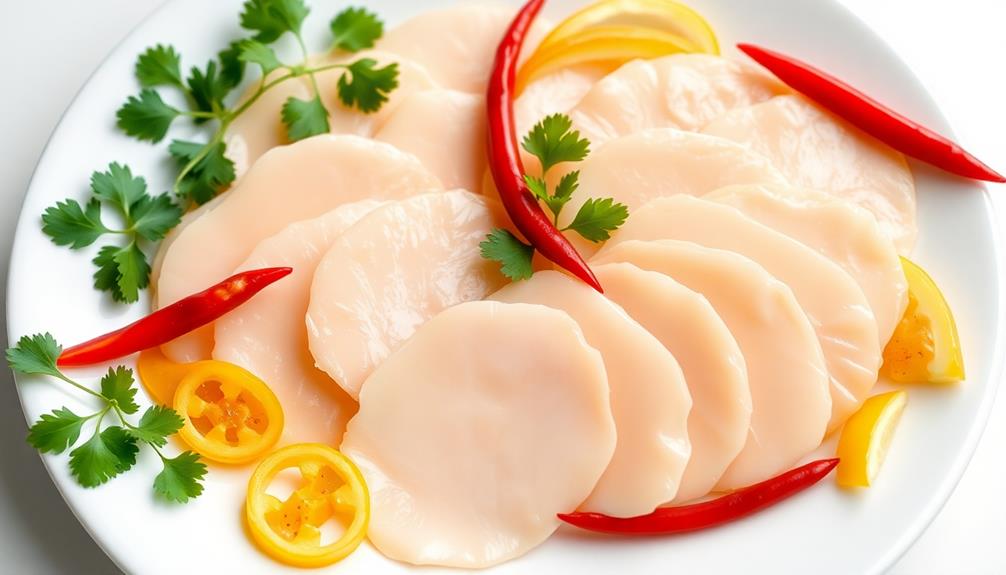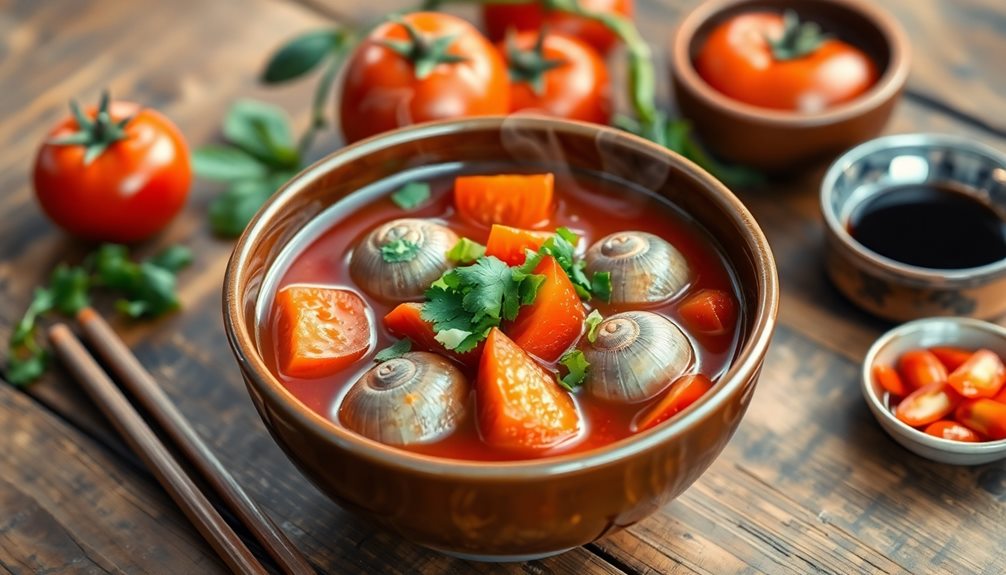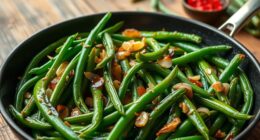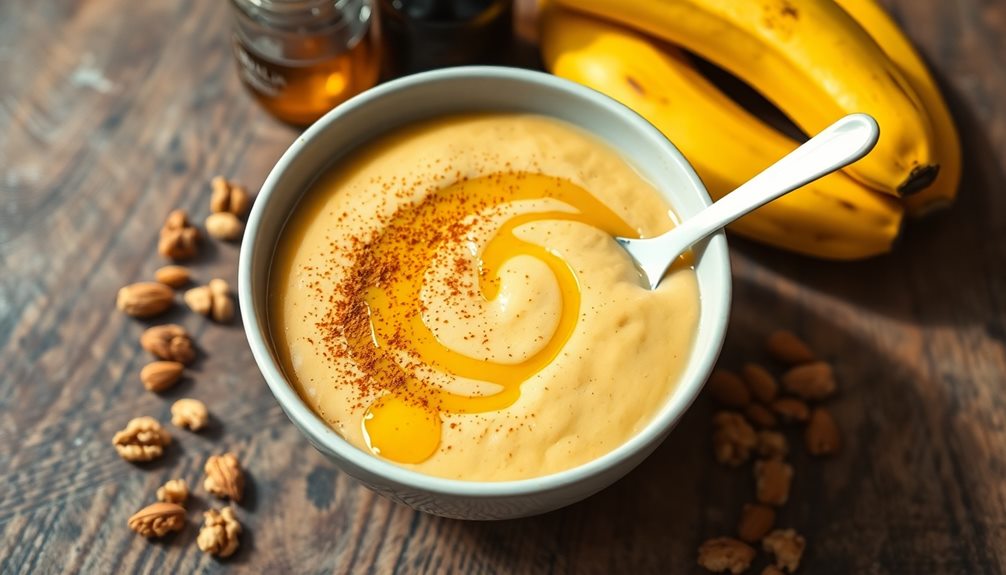Thit Kho Tau is a beloved Vietnamese dish that'll take your tastebuds on a savory-sweet adventure! It features tender pork belly and hard-boiled eggs simmered in a caramelized sauce, creating a mouthwatering harmony of flavors. The pork's richness is balanced by the eggs' creaminess, while fish sauce and brown sugar add depth and warmth. Garnished with vibrant scallions and cilantro, it's a comforting meal that's been delighting families for generations. Serve it over steaming rice, and you'll understand why this dish is a cherished part of Vietnamese culinary heritage. There's so much more to discover about this delightful dish!
Key Takeaways
- Thit Kho Tau is a traditional Vietnamese dish that combines caramelized pork belly and hard-boiled eggs in a savory-sweet sauce.
- The dish has deep roots in Vietnamese culinary heritage, originating from rural farming communities where resourceful cooks utilized every part of the pig.
- The primary ingredients in Thit Kho Tau are pork belly, hard-boiled eggs, fish sauce, brown sugar or caramel sauce, and seasonings like black pepper and garlic.
- The cooking method involves searing the pork, simmering it with fish sauce and soy sauce to create a rich, glossy sauce, and gently adding the hard-boiled eggs.
- Thit Kho Tau is typically served over steamed rice and can be garnished with scallions and cilantro, providing a balance of flavors and textures.
History
Thit Kho Tau, a time-honored Vietnamese dish, has deep roots in the country's culinary heritage. This savory and sweet pork stew has been a beloved family recipe, passed down through generations.
The origins of Thit Kho Tau can be traced back to the rural farming communities of Vietnam, where resourceful cooks would utilize every part of the pig to create nourishing and flavorful meals.
The unique combination of tender pork, hard-boiled eggs, and a caramelized sauce was likely developed to make the most of limited ingredients. Over time, the dish evolved, with families adding their own special touches, like aromatic spices or a splash of fish sauce.
Today, Thit Kho Tau remains a comforting and satisfying dish, enjoyed by Vietnamese people both at home and in restaurants across the country. Its enduring popularity is a testament to the rich culinary traditions that have shaped Vietnamese cuisine for centuries.
Recipe
Thit Kho Tau, or Caramelized Pork and Eggs, is a beloved Vietnamese dish that combines tender pork, hard-boiled eggs, and a rich, savory-sweet sauce. This comforting meal is often enjoyed over steaming white rice, making it a satisfying and flavorful addition to any meal.
The key to a successful Thit Kho Tau is in the caramelization of the pork, which infuses the dish with a depth of flavor that's both complex and addictive. The pork is simmered in a mixture of soy sauce, fish sauce, and a touch of sugar, creating a beautifully glazed and tender texture.
- 1 lb pork belly, cut into 1-inch cubes
- 6 hard-boiled eggs, peeled
- 1/4 cup soy sauce
- 2 tablespoons fish sauce
- 2 tablespoons brown sugar
- 2 cloves garlic, minced
- 1 onion, thinly sliced
- 1 cup water or chicken broth
- 1 bay leaf
- Salt and pepper to taste
In a large pot or Dutch oven, combine the pork, soy sauce, fish sauce, brown sugar, garlic, and onion. Add the water or broth and the bay leaf, and bring the mixture to a simmer over medium-high heat.
Reduce the heat to low, cover the pot, and let the pork simmer for 45 minutes to 1 hour, or until the pork is very tender and the sauce has thickened. Gently fold in the hard-boiled eggs and let them heat through, about 5 minutes.
Season with salt and pepper to taste. For best results, be patient and let the pork simmer gently, allowing the flavors to meld and the sauce to caramelize.
Serve the Thit Kho Tau hot over steamed rice, garnished with sliced green onions or cilantro if desired. Leftovers can be refrigerated for up to 4 days and reheated, making it a great make-ahead dish.
Cooking Steps
First, sear the pork belly in a hot skillet until it's nicely browned.
Then, pour in some fish sauce and let the pork simmer with the eggs until everything's cooked through.
Step 1. Sear Pork Belly in Skillet
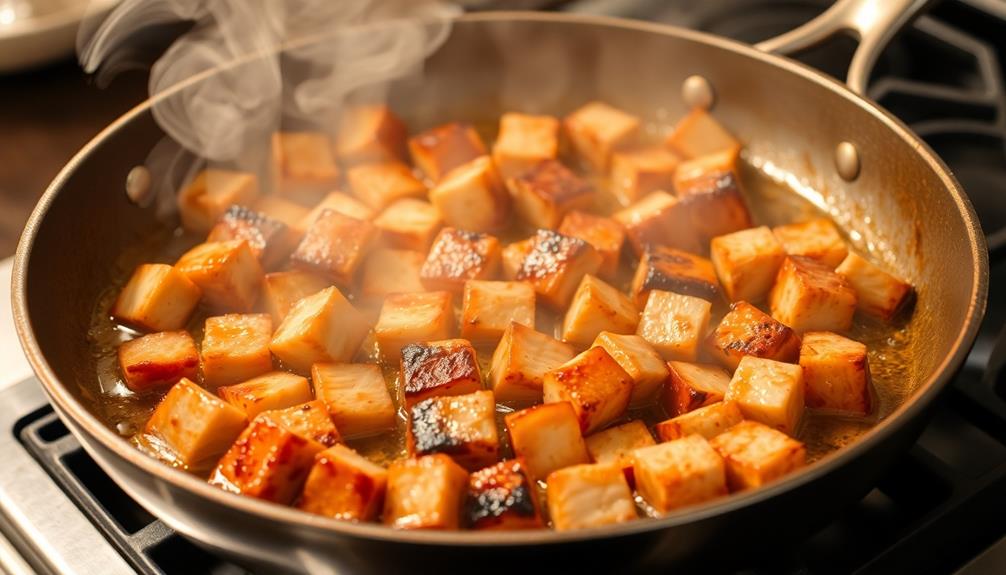
After preparing the pork belly, heat a large skillet over medium-high heat. Once it's nice and hot, you'll want to carefully add the pork belly slices. Sizzle, sizzle! Listen as they start cooking up, creating a mouthwatering aroma that'll have everyone in the kitchen eager to dig in.
Using tongs, gently flip the pork belly so it can get a nice, even sear on both sides. You'll know it's ready when the edges turn a lovely golden-brown color. Be careful not to overcrowd the pan – you want plenty of room for the pork to crisp up perfectly.
As the pork sears, you'll see the fat start to render out, creating a flavorful base for the rest of the dish. Resist the urge to poke at it too much, and let those beautiful caramelized bits develop.
In just a few minutes, you'll have pork belly that's got a delicious crust on the outside but is still juicy and tender on the inside. Get ready for the next steps!
Step 2. Add Fish Sauce
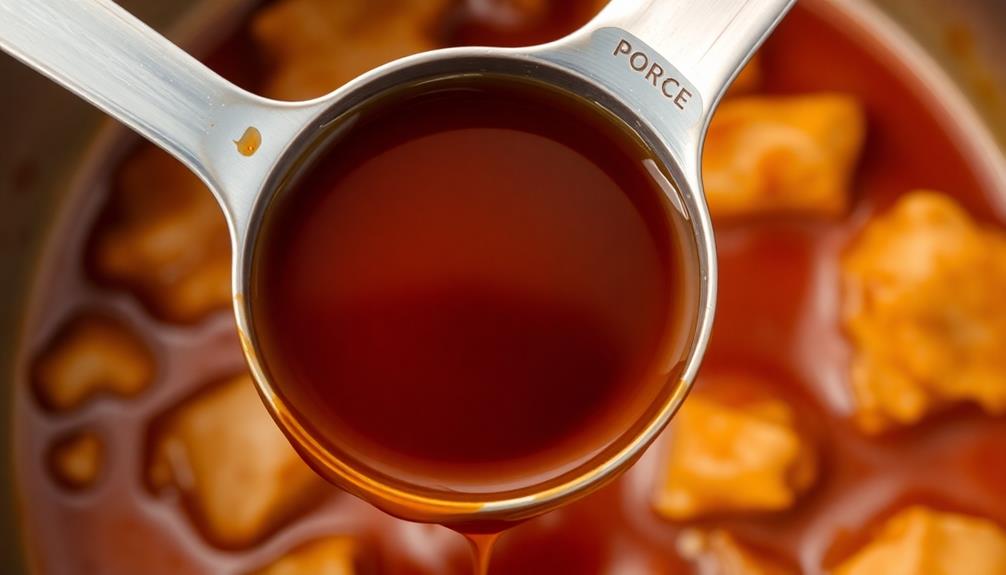
Next, you'll want to add the fish sauce to the pan. This salty, savory liquid will bring such amazing flavor to your caramelized pork and eggs. Just a few tablespoons should do the trick! Finally, if you really want to achieve that authentic taste, you can also add a little bit of tamarind paste to the fish sauce. This combination creates a depth of flavor that is characteristic of a traditional Vietnamese fish recipe. The sweet and tangy tamarind balances out the salty fish sauce, creating a perfect harmony of flavors in your dish. It’s a simple addition that can take your caramelized pork and eggs to the next level of deliciousness.
As soon as the fish sauce hits the hot pan, you'll start to smell that incredible aroma. It'll make your mouth water, for sure.
Stir the fish sauce into the pork and let it simmer for a minute or two. You'll see the sauce start to thicken up and coat the pork beautifully.
The fish sauce really helps to intensify the savory-sweet flavor of the caramelized pork. It's the perfect balance of salty and sweet.
Once the sauce has thickened, you're ready to move on to the next step. Get excited, because the eggs are up next!
This dish is going to be so delicious. Your family is going to love it.
Step 3. Simmer Pork and Eggs Together

With the fish sauce now incorporated, it's time to add the eggs to the pan. Carefully crack each egg into the simmering pork mixture, making sure they're spaced out evenly.
You'll want to keep a close eye on the eggs as they cook, gently nudging them with a spatula to ensure they don't stick to the bottom. Soon, the yolks will start to set, while the whites become deliciously firm.
The colors will start to blend together, creating a beautiful, mouthwatering sight. As the eggs finish cooking, the pork will become even more caramelized, filling your kitchen with the most incredible aroma.
Give everything a gentle stir to incorporate the eggs fully. Now, you're ready to serve this heavenly dish of Thit Kho Tau, with the tender pork and perfectly cooked eggs coming together in perfect harmony.
Get ready for your taste buds to dance with joy!
Step 4. Add Soy Sauce

Adding the soy sauce is an important step in achieving the desired flavor profile for the Thit Kho Tau. This salty and savory liquid will help to balance the sweetness of the caramelized pork and create a well-rounded, delicious dish.
Carefully pour in the soy sauce, letting it gently swirl and mix with the other ingredients in the pot. You'll notice the color of the sauce deepen and the aroma become more robust.
Stir the mixture gently to ensure the soy sauce is evenly distributed. The soy sauce will also help to thicken the overall consistency of the Thit Kho Tau, creating a glossy, mouth-watering sauce that coats the pork and eggs.
Take a moment to admire the rich, inviting hue of the dish as the soy sauce works its magic.
Step 5. Garnish With Scallions and Cilantro
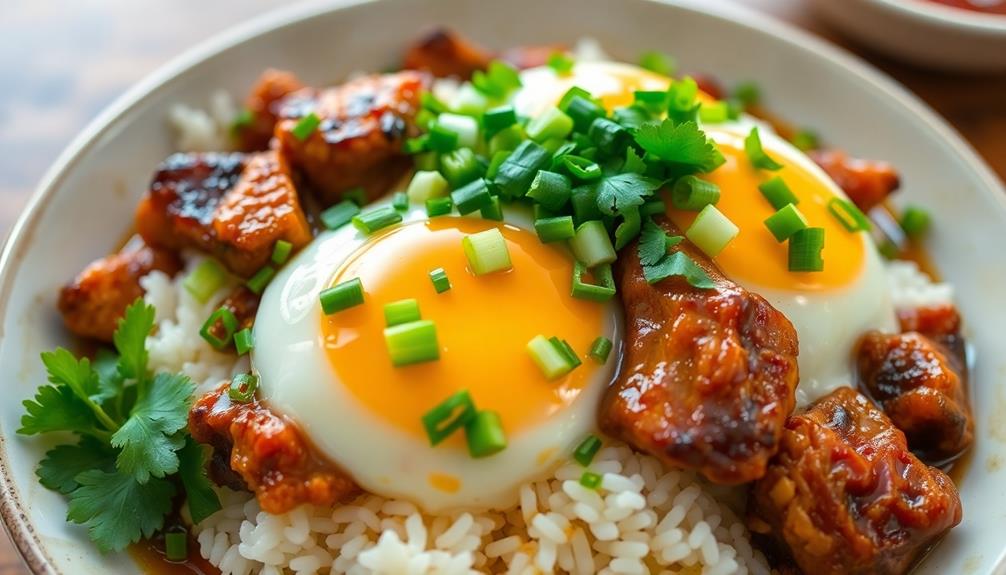
The final flourish to this captivating Thit Kho Tau dish lies in the vibrant garnish of scallions and cilantro. These fresh herbs not only add a pop of color but also a lively, aromatic touch that elevates the entire meal.
Thinly slice the scallions, cutting them at a slight diagonal for a beautiful presentation. Tear the cilantro leaves gently by hand, preserving their delicate texture. Sprinkle the scallions and cilantro over the top of the caramelized pork and eggs, their verdant hues contrasting beautifully with the rich, glistening surface.
With each bite, the cool, herbal notes of the garnish perfectly balance the savory-sweet flavors of the dish. The scallions provide a subtle crunch, while the cilantro imparts a refreshing, citrusy essence that cuts through the richness.
Together, they create a magnificent finishing touch that brings this Vietnamese classic to life.
Final Thoughts
One final note on Thit Kho Tau – this dish is a true testament to the depth of Vietnamese cuisine. The combination of tender, caramelized pork and jammy, soft-boiled eggs is simply irresistible.
You'll be captivated by the way the flavors meld together, creating a dish that's both savory and slightly sweet. The scallions and cilantro add a refreshing, herbal note that balances out the richness of the pork and eggs.
Whether you're enjoying Thit Kho Tau as a main course or as part of a larger spread, you'll be struck by how satisfying and comforting it is. The textures and flavors work in perfect harmony, making each bite a delight.
This dish is a true culinary treasure, and we hope you'll give it a try. With its irresistible flavors and easy-to-follow recipe, Thit Kho Tau is sure to become a new favorite in your household.
Frequently Asked Questions
Is Thit Kho Tau Suitable for Vegetarians or Vegans?
No, this dish wouldn't be suitable for vegetarians or vegans, as it contains pork. If you're looking for a meat-free alternative, you'll need to find a recipe that uses plant-based protein sources instead.
How Long Can Leftover Thit Kho Tau Be Stored?
You can store leftover thit kho tau in the refrigerator for up to 3-4 days. Make sure to store it in an airtight container to maintain freshness. Reheat thoroughly before serving.
Can Thit Kho Tau Be Frozen and Reheated?
Yes, you can definitely freeze and reheat leftover dishes. Just be sure to store them properly in airtight containers, and when reheating, make sure to heat through thoroughly to ensure food safety.
Is Thit Kho Tau Gluten-Free?
Yes, thit kho tau is typically gluten-free. The dish doesn't contain any wheat-based ingredients, so it's a safe option for those following a gluten-free diet. Just be sure to check the specific recipe and ingredients used.
Can the Eggs in Thit Kho Tau Be Substituted With Something Else?
Absolutely, you can substitute the eggs in this dish with other ingredients. Some options include tofu, mushrooms, or even shredded chicken. The key is to find a replacement that complements the flavors and textures of the dish.

